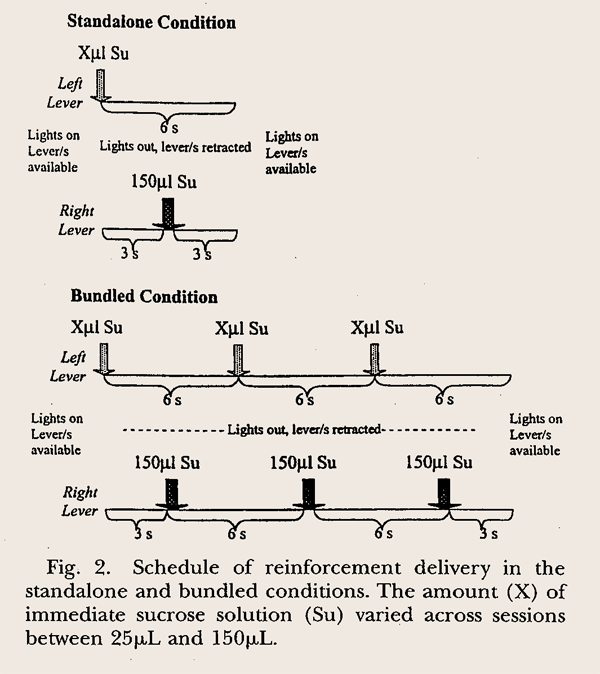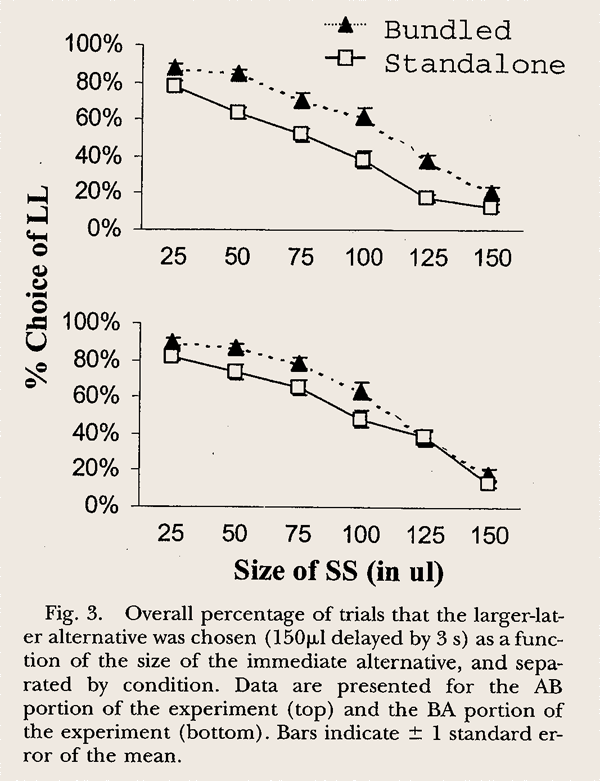`
Excerpt from
Building blocks of self-control:
Increased tolerance for delay with bundled rewards
George Ainslie and John Monterosso
Published in Journal of the Experimental Analysis of Behavior, 79, 37-48.
![]()
Procedure
The procedure was designed to establish the amount of immediate reward that was equally preferred to a standard delayed reward under two conditions—a standalone fixed-ratio 1 (FR1) schedule and a bundled FR1 schedule. In the bundled schedule, the chosen reward was delivered 3 consecutive times following each press (described below).
On each choice trial of the experiment, both levers were available. The left lever produced immediate delivery of sucrose solution, whereas the right lever produced the sucrose solution delayed by 3 s. The reward amount of the delayed alternative was set to 150 μl throughout the experiment (the LL), while the reward amount of the immediate alternative varied across sessions between 25 and 150 μl (the SS). At the beginning of each trial the houselight was turned on and the levers were extended. When either lever was pressed, both levers were retracted, the houselight was turned off, and sucrose solution was delivered after the specified delay (0 s or 3 s) through the central spout. The houselights remained off and levers remained retracted during the interval (ITI), which was set to make the trial duration 6 s. That is, the ITI was 6 s when the delay was 0 s, and 3 s when the delay was 3 s. To ensure sampling of alternatives, four forced- choice trials were scheduled between sets of four choice trials. Forced-choice trials were identical to choice trials except that only one lever was available. Each block of four-forced choice trials contained two trials with each lever, with order based on computerized random selection without replacement. Sessions were continued until satiation, as indicated by a subject’s failure to press an available lever within 60 s. Thus the number of trials varied across sessions.
Trials in the bundled condition were identical to the standalone condition in terms of the presentation of alternatives, the initial delay period, the initial reward delivery, and the period of darkness to complete the 6-s cycle. In the bundled condition, however, without further presentation of the levers, a second 6-s cycle of the chosen delay + reward + darkness followed directly, followed by a third cycle. Only after the end of the third cycle did the houselight turn on and the lever or levers extend to allow the beginning of the next trial. The general layout of trials in both the standalone and the bundled condition are shown in Figure 2.  Because bundled trials delivered three times as much sucrose solution as standalone trials, only a third as many could be conduvted before satiation. The mean number of choice trials before satiation in the bundled condition was 18.6 (55.8 rewards), as compared with 53.7 for the standalone condition.
Because bundled trials delivered three times as much sucrose solution as standalone trials, only a third as many could be conduvted before satiation. The mean number of choice trials before satiation in the bundled condition was 18.6 (55.8 rewards), as compared with 53.7 for the standalone condition.
The delayed (3 s) reward was 150 μL throughout the experiment. The amount of the immediate reward varied across sessions among the following six alternatives: 150 μL, 125 μL, 100 μL, 75 μL, 50 μL, or 25 μL. Standalone and bundled choices were presented in an ABBA design over 72 sessions on separate days as follows: three sessions of standalone choice with each of the six immediate reward amounts in descending order (total = 18); then three sessions of bundled choice with each immediate reward amount in ascending order (total = 18); then 3 sessions of bundled choice with each immediate reward amount in descending order (total = 18); then three sessions of standalone choices with each immediate reward amount in ascending order (total = 18).
Analysis of Individual Choices
To examine overall preference across the group of 8 rats, the mean percentage choice was computed for each session and the data were analyzed as a repeated measure analysis of covariance (ANCOVA) with both amount and experimental condition as within subject variables. This was done (a) over the entire experiment, (b) separately for the first 36 (AB) and second 36 (BA) sessions, (c) using just the first 15 trials of all sessions (to equalize the number of trials across conditions), and (d) using only the first 30 trials from each standalone session and first 10 trials from each bundled session (to minimize the effects of satiation while holding mean consumption constant across conditions).
To examine the generality of the results, the effect of condition was considered individually for each rat. This was done by computing the percent of trials that the delayed reward was chosen in each session and then performing a repeated measure ANCOVA for each rat with percentage choice as the dependent variable, condition as the fixed factor, and delay as a covariate.
Results
 Figure 3 presents the overall percentage choice of the LL reward for all sessions (collapsing across subjects) as a function of the size of the SS and the experimental condition, separately comparing the AB (top) and the BA (bottom) blocks of the experiment. At 50 μl, 75 μ, and 100 μl −− the swing values of SS reward, where preference was not overwhelmingly in one direction −− the lines signifying preference in the bundled condition are substantially above those signifying preference in the standalone condition. This indicates greater preference for the LL in the bundled conditions. The downward slope of the lines indicates the effect that reward amount had no preference. In all conditions the larger the immediate reward, the less frequently subjects chose the delayed 150 μl alternative. Repeated measure ANCOVAs were conducted separately for the AB and BA blocks, modeling percentage preference for the LL reward based on experimental condition (standalone vs. bundled) and amount of the SS. There was significantly greater preference for the LL in the bundled condition in both the AB (F [1, 7] = 31.9, p < .001) and BA analyses (F [1, 7] = 7.0, p = .03). As would be expected, amount was a highly significant predictor of preference in both the AB and BA analyses (F [5, 35] = 284.0, p < .001, and F [5, 35] = 194.0, p < .001 respectively).
Figure 3 presents the overall percentage choice of the LL reward for all sessions (collapsing across subjects) as a function of the size of the SS and the experimental condition, separately comparing the AB (top) and the BA (bottom) blocks of the experiment. At 50 μl, 75 μ, and 100 μl −− the swing values of SS reward, where preference was not overwhelmingly in one direction −− the lines signifying preference in the bundled condition are substantially above those signifying preference in the standalone condition. This indicates greater preference for the LL in the bundled conditions. The downward slope of the lines indicates the effect that reward amount had no preference. In all conditions the larger the immediate reward, the less frequently subjects chose the delayed 150 μl alternative. Repeated measure ANCOVAs were conducted separately for the AB and BA blocks, modeling percentage preference for the LL reward based on experimental condition (standalone vs. bundled) and amount of the SS. There was significantly greater preference for the LL in the bundled condition in both the AB (F [1, 7] = 31.9, p < .001) and BA analyses (F [1, 7] = 7.0, p = .03). As would be expected, amount was a highly significant predictor of preference in both the AB and BA analyses (F [5, 35] = 284.0, p < .001, and F [5, 35] = 194.0, p < .001 respectively).




